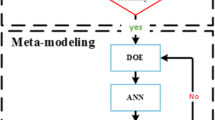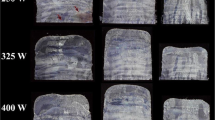Abstract
Deep drawing is characterized by very complicated deformation affected by the process parameter values including die geometry, blank holder force, material properties, and frictional conditions. The aim of this study is to model and optimize the deep drawing process for stainless steel 304 (SUS304). To achieve the purpose, die radius, punch radius, blank holder force, and frictional conditions are designated as input parameters. Thinning, as one of the major failure modes in deep drawn parts, is considered as the process output parameter. Based on the results of finite element (FE) analysis, an artificial neural network (ANN) has been developed, as a predictor, to relate important process parameters to process output characteristics. The proposed feed forward back propagation ANN is trained and tested with pairs of input/output data obtained from FE analysis. To verify the FE model, the results obtained from the FE model were compared with those of several experimental tests. Afterward, the ANN is integrated into a simulated annealing algorithm to optimize the process parameters. Optimization results indicate that by selecting the proper process parameter settings, uniform wall thickness with minimum thinning can be achieved.
Similar content being viewed by others
References
Zhang W, Shivpuri R (2009) Probabilistic design of aluminum sheet drawing for reduced risk of wrinkling and fracture. Reliab Eng Syst Saf 94:152–161
Browne MT, Hillery MT (2003) Optimising the variables when deep-drawing C.R.1 cups. J Mater Process Technol 136:64–71
Wifi AS et al (2007) A review of the optimization techniques applied to the deep drawing process. Proceeding of the 37th International Conference on Computers and Industrial Engineering, October 20–23, 2007, Alexandria
Wang L, Lee TC (2005) Controlled strain path forming process with space variant blank holder force using RSM method. J Mater Process Technol 167:447–455
Gantar G, Kuzman K (2002) Sensitivity and stability evaluation of the deep drawing process. J Mater Process Technol 125–126:302–308
Delamézière A et al (2002) Feasibility in deep drawing: optimization of material properties using response surface. Mécanique Ind 3:93–98
Özek C, Bal M (2009) The effect of die/blank holder and punch radiuses on limit drawing ratio in angular deep-drawing dies. Int J Adv Manuf Technol 40:1077–1083
Padmanabhan R et al (2007) Influence of process parameters on the deep drawing of stainless steel. Finite Elem Anal Des 43:1062–1067
Agrawal A, Reddy NV, Dixit PM (2007) Determination of optimum process parameters for wrinkle free products in deep drawing process. J Mater Process Technol 191:51–54
Singh D, Yousefi R, Boroushaki M (2011) Identification of optimum parameters of deep drawing of a cylindrical workpiece using neural network and genetic algorithm. World Acad Sci Eng Technol 5:167–174
Chamekh A et al (2010) An optimization strategy based on a metamodel applied for the prediction of the initial blank shape in a deep drawing process. Int J Adv Manuf Technol 50:93–100
Özek C, Ünal E (2011) Optimization and modeling of angular deep drawing process for square cups. Mater Manuf Process 26:1117–1125
Wifi A, Abdelmaguid T (2012) Towards an optimized process planning of multistage deep drawing: an overview. J Achiev Mater Manuf Eng 55(1):7–17
Hill R (1950) The mathematical theory of plasticity. Oxford University Press Inc., New York
Sheng ZQ, Jirathearanat S, Altan T (2004) Adaptive FEM simulation for prediction of variable blank holder force in conical cup drawing. Int J Mach Tools Manuf 44:487–494
Thomas W (1999) Product tool and process design methodology for deep drawing and stamping of sheet metal parts. Disertation, Ohio State University
Colgan M, Monaghan J (2003) Deep drawing process: analysis and experiment. J Mater Process Technol 13:235–241
Enzhi G et al (2010) Finite element simulation on the deep drawing of titanium thin-walled surface part. Rare Metals 29:108–111
Watiti VB, Labeas GN (2010) Finite element optimization of deep drawing process forming parameters for magnesium alloys. Int J Mater Form 3:97–100
Shen C, Wang L, Li Q (2007) Optimization of injection molding process parameters using combination of artificial neural network and genetic algorithm method. J Mater Process Technol 183:412–418
Kirkpatrick S, Gelatt CD, Vecchi MP (1983) Optimization by simulated annealing. Science 220:671–680
Kolahan F, Sharifinya A (2009) Simultaneous job scheduling and tool replacement based on tool reliability by proposed Tabu-SA algorithm. J Sci Ind Res-JSIR 68:496–504
Author information
Authors and Affiliations
Corresponding author
Rights and permissions
About this article
Cite this article
Manoochehri, M., Kolahan, F. Integration of artificial neural network and simulated annealing algorithm to optimize deep drawing process. Int J Adv Manuf Technol 73, 241–249 (2014). https://doi.org/10.1007/s00170-014-5788-5
Received:
Accepted:
Published:
Issue Date:
DOI: https://doi.org/10.1007/s00170-014-5788-5




